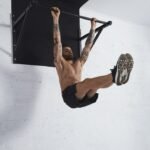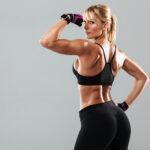Cross Body Hammer Curl (Pinwheel Curls): Exercise Overview
The cross body hammer curl, also known as pinwheel curls, is an effective isolation exercise designed to target the biceps brachii, with a strong emphasis on the brachialis and brachioradialis due to the neutral grip. By curling the dumbbell across the body, this unilateral movement enhances arm definition and helps address strength imbalances between sides. Ideal for sculpting well-rounded arms, this exercise is a valuable addition to arm-focused workouts, upper-body sessions, or full-body routines. Its unique cross-body motion promotes a strong mind-muscle connection, making it suitable for lifters of all levels aiming for aesthetic and functional arm strength (Schoenfeld, 2010).
How to Perform the Cross Body Hammer Curl (Pinwheel Curls)
- Stand with feet hip-width apart, holding a dumbbell in each hand with a neutral grip (palms facing inward), arms relaxed by your sides with a slight bend in the elbows—this is your starting position.
- Engage your core and slowly curl one dumbbell across the front of your body toward the opposite shoulder, keeping your upper arm stationary and elbow close to your torso.
- Pause briefly at the top, squeezing your biceps and brachialis for maximum contraction.
- Lower the dumbbell back to the starting position with control, maintaining tension in the muscle and avoiding contact with your body.
- Repeat with the opposite arm, alternating sides for the desired number of repetitions.
Tips for Optimal Performance
- Maintain Constant Tension: Keep both arms engaged throughout the set, avoiding resting the dumbbells against your body to maximize muscle activation (Schoenfeld, 2016).
- Control the Movement: Perform the curl and descent slowly to enhance time under tension and strengthen the mind-muscle connection, avoiding momentum (McGill, 2010).
- Keep Elbows Fixed: Ensure your elbows remain close to your sides and stationary to isolate the biceps and brachialis, minimizing shoulder involvement (Wirth et al., 2016).
- Avoid Swinging: Maintain a stable torso and avoid leaning or swinging to ensure the target muscles perform the work.
- Breathe Properly: Exhale as you curl the dumbbell upward and inhale as you lower it to support core stability and muscle oxygenation.
- Choose Appropriate Weight: Select dumbbells that allow controlled form for your target rep range (e.g., 8–12 reps per arm for hypertrophy) to avoid compensatory movements.
Boosting your biceps and forearms with hammer curls? Learn their role in our Ultimate Guide to Muscle Groupsfor arm strength.







